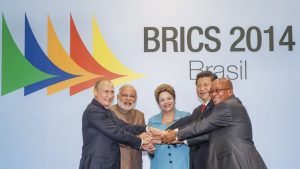
CUBA STANDARD — Three weeks after France’s biggest bank yielded to U.S. pressure, promising it would end all business with Cuba and other U.S.-sanctioned countries, Cuban official media are closely following the creation of a new $100 billion development bank that may offer lower-cost lending alternatives outside the realm of Washington and Wall Street.
The Shanghai-based BRICS bank — called New Development Bank (NDB) — will complement multilateral lenders of last resort and development banks such as the International Monetary Fund and World Bank. Cuba is not a member of these UN institutions in part because the United States, which controls much of their governance, blocks Cuba’s accession. Cuba has also been a critic of the conditions the World Bank and IMF attach to loans, such as liberalization, deregulation and privatization.
The BRICS countries — Brazil, Russia, India, China and South Africa — account for 25 percent of global GDP and 40 percent of the world’s population. China this year will surpass the United States as the world’s largest economy, and the BRICS nations are the biggest net contributors to the IMF, but they have little say in the UN institutions’ governance.
Discussion about a BRICS bank began three years ago, and negotiations have advanced steadily, culminating in an agreement announced today in Fortaleza, Brazil. The five nations agreed to base the NDB in Shanghai, it will be first be presided by India, with Russia as chairman of the representative board (made up of member countries’ finance ministers and central bank chiefs), and it will have a governing structure that requires four of the five nations to approve new policies. Each BRICS member is expected to put an equal share into establishing the startup capital of $50 billion, with a goal of $100 billion.
Lending is expected to begin in 2016; the NDB will also consider lending to non-BRICS nations, Brazilian President Dilma Rousseff said during the BRICS summit in Fortaleza.
Cuba has used loans from Brazil’s BNDES, the China Development Bank, and Russia’s Vneshtorgbank, to expand a refinery, build a container terminal at the Port of Mariel, and purchase Russian passenger jets. But the new BRICS bank could allow it to fund broader infrastructure projects such as road, railroad, water and energy construction, which go beyond the specific business interests of just one partner nation.
“While the BRICS bank may not cover the total financing needs of all emerging economies, a $100 billion fund is enough to make a difference to the infrastructure projects in some smaller emerging economies with fiscal problems and a volatile currency,” Zha Xiaogang, head of the Shanghai-based Institute for World Economy Studies, told Xinhua news service.
The five nations also agreed to create the Contingent Reserve Arrangement (CRA), a $100 billion crisis lending fund designed to relieve short-term liquidity pressures. China will contribute $41 billion, Russia, Brazil and India will chip in $18 billion each, and South Africa will contribute $5 billion. Cuba could benefit from CRA loans in a repeat of crises such as the one in 2008, when it had to drastically cut imports and freeze hard-currrency accounts.
U.S. sanctions against Russia made the Russian government an enthusiastic supporter of the BRICS bank, suggests Nobel prize winner Joseph Stiglitz, which helped reach an agreement.
“In spite of all of the differences, the emerging markets can work together, in a way more effectively than some of the advanced countries can work together,” the former World Bank chief economist said on the Democracy Now news program recently.
“This new institution is not going to change everything. It’s just a little bit of movement, but it’s a movement in the right direction, reflecting the new economic and political realities and reflecting the learning that we’ve done in the last 70 years.”

